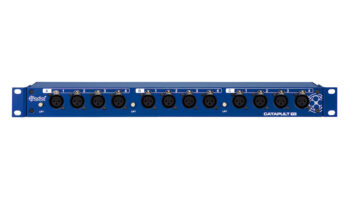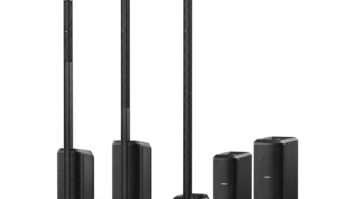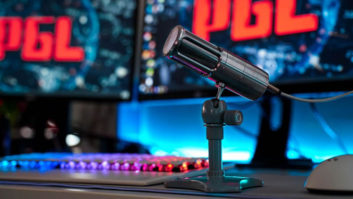In 1996, Earthworks came seemingly out of nowhere with the TC30K, an
omnidirectional microphone that featured response
up to 30 kHz and got rave reviews. “Baby B&Ks” was a description
heard often, and the shape was certainly suggestive of B&Ks.
However, Earthworks did not come out of nowhere. The company was
founded in 1979 by audio legend David Blackmer (the “db” of dbx) and
was first engaged in moving earth and reconditioning the old brick mill
building where the company is now housed. Earthworks followed up the
TC30K with the TC40K omni, which upped the response to 40 kHz and
garnered yet more acclaim. By the time the QTC1 (yet another omni with
lower noise and higher sensitivity) was released, the cry from
recording engineers for a cardioid version of these wondrous
instruments had become a din.
The Z30X is Earthworks’ answer to the call and, let me say right up
front, it fulfills every expectation. To ensure full appreciation of
the company’s handiwork, Earthworks has also introduced the Lab 102, a
high-quality, 2-channel mic preamp.
Like most of the Earthworks microphone family, the Z30X is long and
slim and has no ancillary features: No HPF, no pad, no pattern switch.
It’s a cardioid microphone, plain and simple, with a
31/48-inch Mylar diaphragm. At about eight ounces, the Earthworks is
pretty much of a lightweight and is relatively easy on the pocketbook:
The Z30X is $750, or $1,600 for a matched pair.
SPARTAN PANEL LAYOUTS
For most of my evaluation of the Z30X I used it in conjunction with the
$1,500 Lab 102 preamplifier. (The preamp is also available in a
single-channel form as the $750 Lab 101.) The Lab 102 comes in a
single-rackspace box that, like most mic preamps, features rather
Spartan front and rear panel layouts. For each channel, the front panel
has a polarity switch, phantom power switch and indicator LED, standby
switch, stepped gain switch (with 6dB steps), clip LED and variable
output pot. The clip LED begins to flash at 90% of the maximum level
before clipping, and the LED stays on for a period proportional to the
signal; if hard clipping occurs, the LED stays on for a full second.
This is one indicator that actually gives some useful information.
The rear panel has, for each channel, an XLR input and two XLR outputs. One of the outputs
offers a stepped output level; the other’s level is controlled by the
front panel output level pot. Additionally, the variable output is
available on a 11/44-inch TRS jack. I used the variable output almost
exclusively. The Lab 102 has some heavy-duty specs, such as its ability
to accept peaks up to 14V (10V RMS) at the input and output up to the
same 14V, and its frequency response, which is stated as 1 to 200k Hz,
give or take a half a dB! Alrighty, then.
I used the Z30X on a number of different sources, and, while no
microphone is ideal for every application, the Z30X proved extremely
versatile. I first used it to record the great wind player Paul
McCandless who, for this session, played mainly soprano sax. I set the
mic on a stand, went into the control room, plugged it into the Lab
102, and brought up the level to be sure it was working. Boy, was it
working. I hadn’t even placed it yet and it immediately sounded
luscious, full and even across the spectrum. And it sounded even better
once I worked the placement some. To say I was impressed right off the
bat is an understatement.
The Z30X captured a phenomenal amount of detail—even the sound
of the keys being fingered was absolutely accurate. “Clarity” and
“detail” are words I’ve seen in every single Earthworks microphone
review I’ve read, and those are indeed the best words to describe the
sound of the Z30X. This first impression held through every single
trial I gave the microphone, even in those few cases where I didn’t
feel it was the best tool for the job.
Using a matched set of Z30Xs—which came in a beautiful
cherrywood box—I recorded myself playing vibraphone, trying
several configurations, including coincident, ORTF and spaced. As with
such experiments in the past, the spaced pair gave the best results. Vibes are a
very revealing source for testing microphones, as the tone is pure and
bell-like, which often reveals “hot” areas in many microphones’
responses. Further, when multiple notes are ringing there is frequently
very strong interaction between the harmonic partials of the notes,
which has actually overloaded the capsules or preamps (it’s hard to
know which) of some microphones I’ve tried. The Z30Xs were completely
unfazed (so to speak) by this behavior. Once placement was tweaked, the
Z30Xs produced a beautiful, wide stereo image that was even throughout
the range of the instrument. Imaging was exceptional, with the highest
notes full right, lowest notes full left and the center of the keyboard
dead center in the image.
While I had the mics set up for recording the vibes, I took the
opportunity to try putting the Z30Xs through a different mic
pre—one of good, but not outstanding, quality. The sound of the
microphones was still superb, but the test clearly demonstrated the Lab
102 to be of outstanding, not just good, quality, with the greatest
difference being in openness and accuracy of the high frequencies.
Setting the Lab 102’s gain for this recording, I noticed that the Z30Xs
are capable of quite high output levels, up to 10 volts into 5
kilohms.
I also tried using several “workhorse” microphones, including
Sennheiser 421s and Shure Beta 87s, with each of the preamps, which, as
expected, showed the Lab 102 to be the better mic pre and the Z30Xs to
be far superior microphones.
I loaned the mics to the multitalented Nick Peck who, in his guise
as a recording engineer, was recording a live album of Ali Akbar Khan
in concert with a small orchestra. Peck used the Z30X pair as distant
mics to capture the sound of the 40 musicians in the hall and raved
about the clarity and openness of the sound, as well as the imaging,
which he found quite remarkable.
I couldn’t very well evaluate a pair of small-diaphragm condenser microphones without trying them as drum
overheads. As a drummer, I am rather fussy about drum overheads, but I
do not exaggerate when I say that I liked the Z30Xs better than any
other microphone I have ever tried, except for B&Ks. As with the
vibes, the imaging, balance through the kit (even the kick was well
balanced in the mix), and, most notably, clean reproduction of the high
end, on cymbals and snare especially, were awesome. There was no washy
smearing on the cymbals; the articulation was perfect. In fact, for a
real grungified bash-and-smash sound, the Z30Xs truly might be too
good!
While recording drums, I tried using the Z30Xs as tight mics on
snare and toms. (Alas, I ran out of time before trying one on the
kick.) Tonally, these tests were just as pleasing as the others: all
the snap and crack one could ask from a chrome snare, and both body and
attack on the toms. The Z30Xs seemed perfectly happy to take the high
SPL—the mic is rated for a max input level of 145 dB SPL—but the resulting output from the
snare mic was so high that every gain setting of the Lab 102 except the
absolute lowest resulted in occasional clipping. At that point, I
wondered whether the lack of a pad on the Lab 102 could be a problem if
recording a serious pounder of a drummer. (I tend to hit the drums
pretty hard, but drummers used to playing at very high volumes do hit
harder.)
About this time, I was thinking the Z30X could do no wrong. I wasn’t
too far from the truth, but I did finally find an application that left
me just slightly less thrilled with this astonishing instrument. I
tried the Z30X for voice-over work and found it less than ideal in two
ways. First, I am often looking for some sort of distinctive coloration
when recording vocals, and while I would certainly say the Z30X has its
own sound, it did not provide the “character” I was looking for. Of
course, every voice is different, and vocal applications vary widely,
so I can envision a case in which the Z30X would excel at vocal
recording, but that was not the case in the uses I had for it. Still,
it didn’t sound bad on voice-over, it just wasn’t my first choice.
The only other aspect of the Z30X I could cite as a shortcoming was
the proximity effect, which was very pronounced when
working the mic close (6 inches or less). Recording an actor who likes
to work very close on the mic, I applied substantial LF roll-off and still was getting too much bass,
which eventually had to be rolled off during post-processing. However,
this same characteristic was a plus when tight-miking toms on a drum
kit.
SOME SMALL GRIPES
I should mention some of the Lab 102’s flaws. Although fanaticism in
the pursuit of fidelity is a great virtue, it sometimes leads to small
decisions, regarding features, where I disagree. For one, the Lab 102
has no AC switch. This is something I find particularly annoying. There
are several circumstances in which I prefer to power a piece of
equipment down without unplugging it. The Lab 102 also uses an outboard
power transformer, but Earthworks has wisely opted for the tolerable
“lump in the line” approach rather than the classically inconvenient
“wall wart.”
The other point where I differ with Earthworks is in the Lab 102’s
use of unbalanced outputs. To be precise, the signal cold conductor is
not connected to ground (as the rear panel graphics indicate), but it
is a signal return, not a 180degrees phase-flipped image of the signal
hot conductor. Earthworks asserts this was done to avoid adding another
stage to the signal chain, which I do appreciate, but I think there are
many applications where engineers would choose to put the preamp close
to the microphone and have their long cable run be from the preamp to
the console or recorder, rather than from the mic to the preamp. In
this circumstance, it is desirable to have the superior common mode
rejection, which balanced lines allow, of interference that may be
picked up along the run. The degradation of one more line amplifier (which, knowing Earthworks, would be of
impeccably high quality anyway) would be worthwhile to me in exchange
for making it easier to rid my audio of the far greater degradation the
cruel world can impose in transit. Further, the unbalanced outputs put
the Lab 102 more at the mercy of the topology of the input stage of the
next piece of equipment in line. Perhaps Earthworks will consider a
balanced option in future products.
I conducted several experiments to check the off-axis response of
the Z30X and found that the only noticeable tonal alteration was some
roll-off in the low frequencies. At the null points in the mic’s pickup
pattern the recording contained virtually no direct sound at all, just
a little bit of room reverberation. It is my opinion that this
smoothness in the off-axis response is a major contributor to the
spectacular results I got using the Z30Xs in a spaced pair
configuration. In my tests, the Z30X’s noise level was never audible
above the quiescent noise in the studio, but I did not have the
opportunity to work with them in a room as critically quiet as a good
Foley stage. (The Z30X noise spec is given as 22 dB SPL,
A-weighted.)
Earthworks also gave me the opportunity to evaluate the Z30XL ($900
each, $1,900 for a matched pair), a hypercardioid version of the Z30X. I used this mic
for voice-over work (in order to minimize room sound) and it was used
extensively for Foley recording in a less-than-optimal environment that
similarly required a tighter pattern to avoid unwanted pickup. The
Z30XL’s characteristics were, of course, nearly the same as the Z30X. I
detected just a wee bit more coloration in the off-axis response, which
I would expect in a hypercardioid, but Nick Peck, who did the Foley
recording wearing his sound designer hat, disagreed, saying that
decreased level was the only effect he heard in off-axis pickup. Peck
remarked especially on the clarity of low-level detail when recording
effects like paper being manipulated.
By now, dear reader, you must have noticed the great quantity of
superlatives I have dispensed throughout this review. On rare occasion,
I review a product that absolutely floors me and leaves me so
enthusiastic I am almost embarrassed by how my own copy gushes. The
Z30X is such a product; put simply, it just kills. To me, microphones
and speakers are the toughest things to really get right and the most
exciting when they are. My ardor for this microphone is rooted in my
love of sound and music, my perfectionist nature and the thrill of
coming across a tool that not only meets but exceeds my standards.
Not to be given short shrift, the Lab 102 is also an exceptional
piece, providing extremely accurate and quiet amplification, and is
plainly the ideal companion for the Z30X.
Everyone’s mic cabinet can use another pair of good, small diaphragm
condensers and everybody’s rack can hold one more high-quality preamp.
Value for the money is simply not a question for the Z30X and Lab 102,
and neither is performance. At these prices, the only question should
be when you will place your order.
Earthworks, www.earthworksaudio.com







